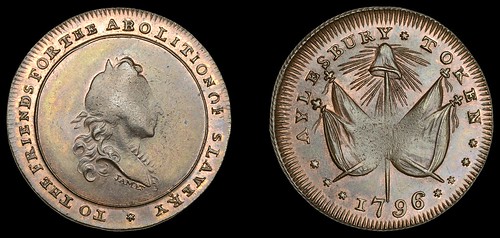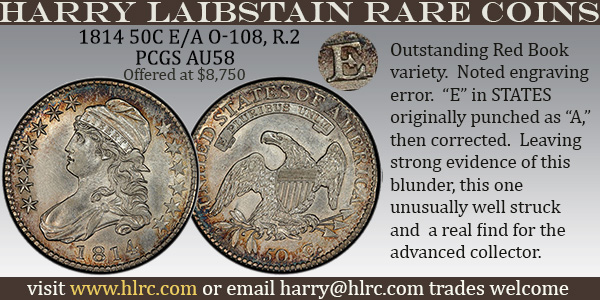
PREV ARTICLE
NEXT ARTICLE
FULL ISSUE
PREV FULL ISSUE
MORE ON THE AYLESBURY ABOLITION OF SLAVERY TOKENHere are reader responses to David Pickup's query about this token. -Editor 
Peter Preston-Morley writes: "I was interested to see David Pickup's contribution on the Aylesbury token in your latest E-Sylum.. As your readers who collect Conder tokens will know, the piece is not uncommon. James is the signature of the artist, Charles James, who was also responsible for the Aylesbury halfpence issued by Francis Wheeler, which bear the same date, 1796. James seems to have been a peripatetic figure, working for a number of token manufacturers in England at the time, including William Lutwyche (who coined these Aylesbury slavery abolition tokens) and Peter Skidmore. "I wonder if the Thomas Lloyd, MA, to whom David refers is the same person recorded in 1803 as being resident at Peterley House, Great Missenden (10 miles from Aylesbury). The Clergy of Church of England Database shows that a Thomas Lloyd, MA, was licensed as a curate in Aylesbury on 21 February 1780, on a stipend of 60 GBP "plus surplice fees", advancing to Vicar on 2 February 1791, ceasing his post on 16 August 1796. A William Lloyd, DD, a former pupil of University College, Oxford and perhaps a relation, then took over as Vicar in August 1796, advancing to Rector on 6 July 1809; he died in post on 19 April 1816. "One is tempted to ask whether, on the basis of the date on the token and the incidence of Thomas Lloyd leaving his post, something happened in Aylesbury in the summer of 1796 which links the appearance of the token to Lloyd's resignation. "The weak definition in the centre of these tokens is a characteristic of those struck on lighter flans of circa 9 grams (Dalton & Hamer 7, 7a and 7b), whether the edge is inscribed or grained. Those on flans with plain edges (DH 7c) generally weigh circa 12-13 grams and these are almost always better struck and have tended to survive in nicer condition. I attach an image of a plain edge specimen." 
Gary Groll writes: "The token was manufactured by William Lutwyche. Not all examples have a weakness in the center; just the ones struck on thin planchets. Those struck on thicker planchets display more detail. "The cap as displayed on the reverse is similar to the Phrygian-style cap that became a symbol of Revolutionary France. It appears on a number of 18th century British Tokens “James” under the bust refers to Charles James, the engraver. "I don't know why the portrait of William III was selected for this specific variant, but his likeness continued to appear on tokens throughout the 18th c token series." Thanks, everyone. -Editor
To read the earlier E-Sylum article, see:

Wayne Homren, Editor The Numismatic Bibliomania Society is a non-profit organization promoting numismatic literature. See our web site at coinbooks.org. To submit items for publication in The E-Sylum, write to the Editor at this address: whomren@gmail.com To subscribe go to: https://my.binhost.com/lists/listinfo/esylum All Rights Reserved. NBS Home Page Contact the NBS webmaster 
|